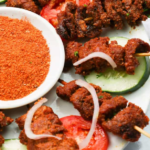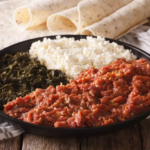Sudanese cuisine is a treasure trove of flavors and textures, and one dish that stands out for its simplicity and heartiness is Kissra. Kissra is a traditional Sudanese flatbread made from sorghum flour, and it holds a special place in Sudanese culture as a staple food that has nourished generations. With its rustic charm and wholesome taste, Kissra embodies the spirit of Sudanese cuisine.
The Essence of Kissra
Kissra is more than just a bread—it is a symbol of tradition, community, and resilience. It has been a dietary staple in Sudan for centuries, providing sustenance and comfort to families across the country. The process of making Kissra is simple yet labor-intensive, requiring skill and patience to achieve the perfect texture and taste.
The Making of Kissra
To make Kissra, sorghum flour is mixed with water and a pinch of salt to form a thick batter. The batter is then poured onto a large round griddle or skillet, known as a tawa, and spread out in a circular motion to create a thin, flatbread. The skilled hands of Sudanese women deftly maneuver the batter, ensuring an even distribution and thickness.
Cooking Kissra
The tawa is heated over a charcoal or gas stove, allowing the batter to cook slowly and evenly. As the heat permeates the batter, the flatbread gradually sets and develops a golden-brown crust. The surface of Kissra may bubble and develop small holes, adding character to its appearance.
The Texture and Taste
What sets Kissra apart is its unique texture. The sorghum flour gives the bread a slightly dense and chewy consistency, while the crust provides a satisfying crunch. The flavor of Kissra is earthy and subtly nutty, with a hint of sweetness from the sorghum. The natural sweetness of the grain adds depth to the overall taste, making each bite a delightful experience.
Serving Kissra
In Sudanese culture, Kissra is often enjoyed as a communal meal. It is served alongside a variety of dishes such as stews, dips, and vegetables. The bread is torn into pieces and used as a vessel to scoop up the accompanying dishes, adding a touch of warmth and heartiness to the meal.
Kissra is also a popular street food in Sudan, with vendors skillfully flipping and grilling the flatbread on large open grills. It is often enjoyed on its own, eaten hot off the grill, or paired with a simple spread of butter or honey for added indulgence.
The Significance of Kissra
Kissra holds a special significance in Sudanese culture beyond its role as a dietary staple. It represents the resilience and resourcefulness of the Sudanese people, who have found sustenance and comfort in simple ingredients and traditional cooking methods for generations.
Sudanese Kissra is a testament to the rich culinary heritage of Sudan. Its humble origins and hearty nature make it a cherished part of Sudanese cuisine. Whether enjoyed as a communal meal or savored as a street food delight, Kissra brings people together and fills hearts and stomachs with its wholesome goodness. So, if you have the opportunity to taste Kissra, embrace the experience and savor the flavors of this beloved Sudanese flatbread.








